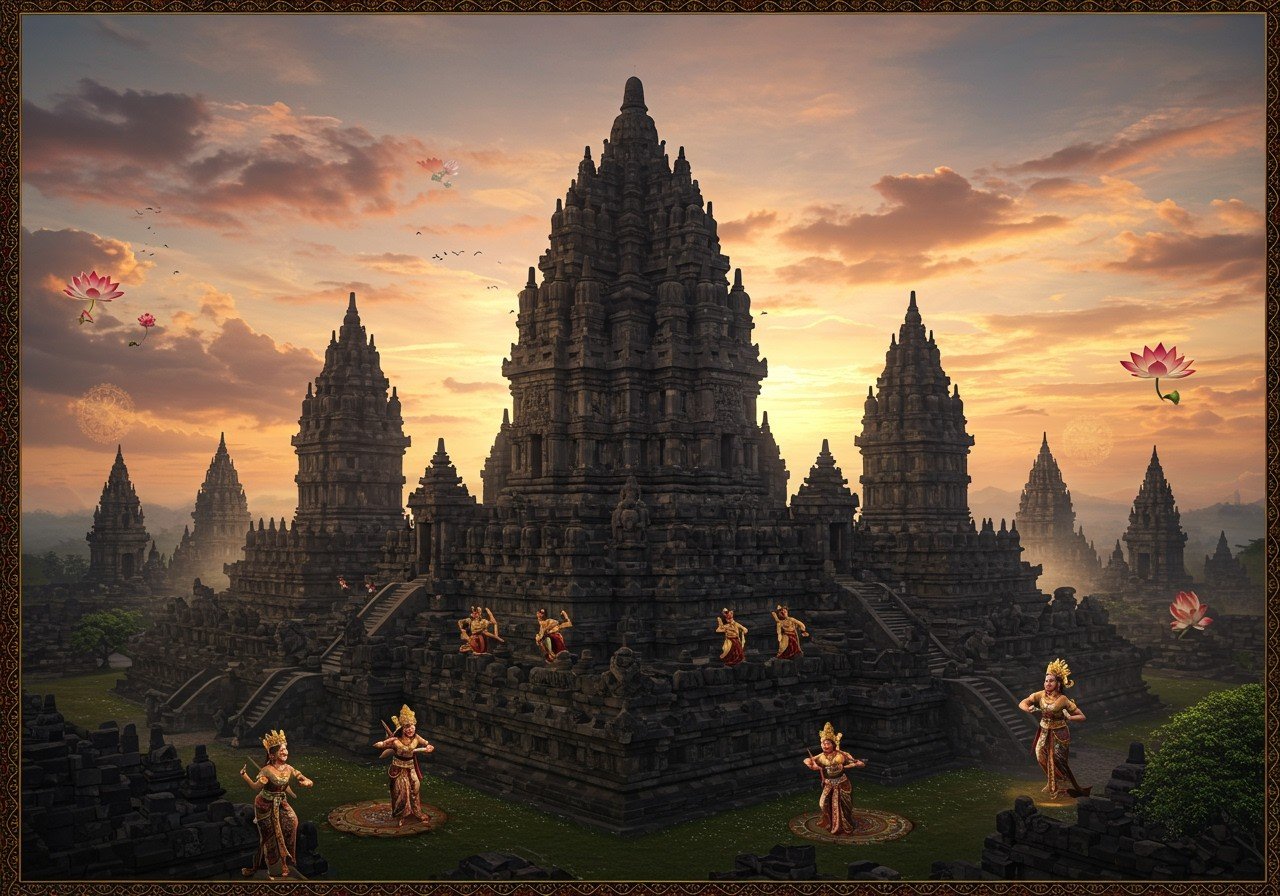
Nestled in the heart of Java, Indonesia, lies Prambanan Temple, also known as Candi Rara Jonggrang—a magnificent 9th-century Hindu temple complex. This architectural marvel stands as a proud testament to the rich spiritual devotion and extraordinary craftsmanship of the ancient world. Located near Yogyakarta, close to the border between Yogyakarta and Central Java, Prambanan Temple draws visitors from across the globe, eager to witness its timeless beauty.
Architectural Splendor: A Symphony in Stone
Prambanan Temple exemplifies the pinnacle of Hindu architectural design. The central building dedicated to Lord Shiva soars 47 meters high, a beacon of faith against the sky. Around it cluster 240 smaller temples, each whispering tales of devotion. The entire complex adheres to the mandala pattern, a symbolic representation of the universe in Hindu cosmology. Three primary temples dedicated to Brahma, Vishnu, and Shiva (the Trimurti or divine trinity) form the spiritual heart of Prambanan.
The temple’s towering structures, known as ‘vimanas,’ clearly show the influence of South Indian architecture. Intricate bas-reliefs narrate scenes from the epic Ramayana, showcasing the remarkable artistry of the period. Painstaking restoration work, particularly after the 2006 earthquake, has preserved these delicate carvings, ensuring that their stories continue to captivate visitors.
Andesite Stone: A Canvas for Devotion
Built primarily with andesite stone, readily available in the region, Prambanan reflects the ingenuity of its builders. They skillfully employed interlocking stone blocks, a technique that provided structural stability without the need for mortar. This sophisticated method underscores their advanced knowledge of engineering principles. The clever integration of water management systems within the design speaks to the meticulous planning and foresight that went into the temple’s construction.
Local artisans played a crucial role in shaping the temple’s beauty, painstakingly carving elaborate designs that adorn its walls. Their dedication speaks volumes about the socio-economic fabric of the time and their collective desire to honor the divine.
Explore our exquisite collection of Holy Idols.
A Journey Through Time: History and Significance
Prambanan Temple emerged during the 9th century under the reign of the Hindu Sanjaya Dynasty. Its construction signified the resurgence of Hinduism in Java after a period marked by Buddhist dominance. The temple complex served as a hub of political and religious life, embodying the power and piety of the ruling dynasty.
The captivating legend of Roro Jonggrang adds a touch of cultural mythology to Prambanan’s rich history. Rediscovered by Dutch explorers in the 19th century, this historical treasure earned its place as a UNESCO World Heritage Site, a recognition of its universal cultural significance.
- Location: Situated on the border of Yogyakarta and Central Java, about 17 kilometers northeast of Yogyakarta city, Prambanan is easily accessible.
- It is truly breathtaking to see it yourself and witness this marvel.
- History: The largest Hindu temple in ancient Java, Prambanan’s construction commenced in the mid-9th century, likely initiated by Rakai Pikatan and consecrated by his successor, King Lokapala.
- The meticulous detailing and planning that went into building this testament are commendable.
- Purpose: Historians believe the Sanjaya Dynasty built Prambanan to mark their return to power in Central Java after a period of Sailendra Dynasty Buddhist rule.
- It represents so much of ancient history and its truly spectacular.
Cultural Relevance: A Living Legacy
Prambanan Temple continues to be a vibrant center for cultural and spiritual activities. The annual Ramayana Ballet performances, held against the backdrop of the illuminated temples, bring ancient tales to life through traditional dance, music, and storytelling. These captivating performances make the epic accessible to modern audiences, bridging the gap between generations.
For Indians, Prambanan serves as a powerful reminder of shared cultural and spiritual heritage, resonating through art, literature, and folklore. The temple’s enduring presence inspires awe and reverence, inviting us to appreciate the artistry and spirituality that have shaped our world.
Balancing the needs of tourism with the crucial task of preservation ensures that this extraordinary legacy remains intact for generations to come, allowing future generations to experience its beauty and draw inspiration from its profound significance.
Find traditional attire perfect for spiritual occasions
Poojn.in: Bringing the Sacred Home
Inspired by the grandeur of Prambanan Temple? Bring a touch of that sacred atmosphere into your home with authentic puja items from Poojn.in. We understand the deep-rooted connection between temple architecture and personal worship, and we offer a curated selection of items to enhance your spiritual practices.
- Brass Temple Bells: Just like the bells that resonate through ancient temples, our brass bells create a pure, resonant sound, elevating your puja experience. Crafted with high-quality brass, they require minimal care and maintain their beautiful sheen.
- Bring the ancient energy home today.
- Decorative Diyas: Our intricately designed brass diyas beautifully reflect the traditional lighting seen in temples. Durable and aesthetically pleasing, these diyas are ideal for daily aarti and special occasions.
- Enhance your spiritual journey with our exquisite diyas.
- Incense Holders: Complement your home altar with our traditional brass incense holders, perfectly suited for temple-style worship.
- Create a truly traditional atmosphere at home today.
Connect with Us:
- Phone: 03369029784
- WhatsApp: 9476142738
All our products are:
- Made by skilled artisans
- Crafted from premium materials
- Designed for lasting use
- Ideal for traditional puja
Embracing Prambanan’s Enduring Legacy
Prambanan Temple transcends mere architecture; it’s a living bridge between eras, inviting us to immerse ourselves in its timeless beauty and profound significance. Walking through its courtyards, gazing at the intricate carvings, one feels the pulse of history and the whispers of devotion echoing across time. For those seeking a deeper connection with our shared cultural roots, Prambanan stands as a testament to the enduring power of creativity and faith.
Whether you experience Prambanan in person or explore its wonders virtually, its legacy continues to inspire awe and reverence. It reminds us of the rich tapestry of stories and beliefs that connect us across continents and centuries. Prambanan is a window into the soul of a culture that cherishes its past while embracing the future.
Common Questions About Prambanan Temple
What materials were used to construct Prambanan Temple? Prambanan Temple is primarily constructed from andesite stone, a volcanic rock abundant in the region. The builders skillfully carved and interlocked these stones without mortar, demonstrating remarkable engineering prowess.
What makes Prambanan Temple so renowned? Prambanan’s fame rests on its breathtaking architecture, rich history, and spiritual significance. As the largest Hindu temple complex in Indonesia and a UNESCO World Heritage Site, it draws visitors worldwide who are captivated by its intricate carvings and towering structures.
How old is Prambanan Temple? Prambanan Temple dates back to the 9th century, specifically the mid-800s CE. This ancient marvel has endured for over a millennium, a testament to the ingenuity of its creators and the resilience of its structure.
What is the architectural style of Prambanan Temple? Prambanan exhibits a distinct Hindu architectural style, characterized by tall and pointed towers, known as shikharas, a hallmark of Hindu temple design. Influences from South Indian architecture are evident in the tiered structure of the vimana towers.
How many temples are within the Prambanan complex? The Prambanan Temple complex originally comprised 240 temples. While not all remain intact, the central compound still houses numerous shrines, including the main temples dedicated to the Trimurti and surrounding smaller structures.
What is the cultural significance of Prambanan Temple? Prambanan holds immense cultural significance, representing the rich Hindu heritage of Indonesia. It serves as a reminder of a time when Hinduism flourished in the region and continues to be a place of worship and cultural celebration. Its recognition as a UNESCO World Heritage Site underscores its global importance.
Is Prambanan Temple still an active place of worship? While not used for daily rituals like smaller local temples, Prambanan Temple remains a sacred site for Hindus. Religious ceremonies and festivals are occasionally held within the complex, keeping its spiritual significance alive.


